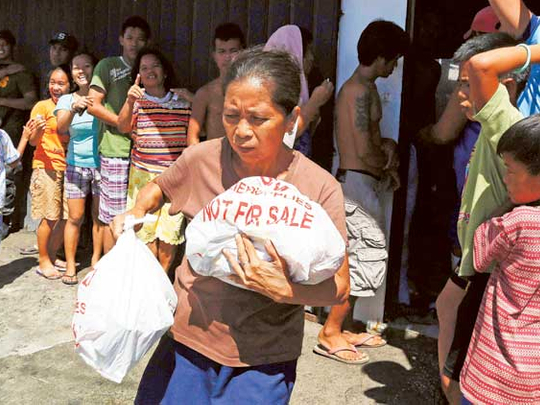
Manila: Eight people died in a stampede at a government-run rice warehouse and several thousands were stranded after they failed to catch commercial and subsidised flights in a desperate bid to leave central Philippines — now a heart-rending typhoon-wasteland — sources said.
The eight were killed in the commotion at a warehouse of the National Food Authoritiy (NFA) in Alangalang town, Leyte, near Tacloban, NFA spokesman Rex Estoperz said in a radio interview. The area was heavily damaged by Typhoon Haiyan last Friday.
“Eight people died on the spot when one of the walls of the NFA warehouse collapsed [during the stampede],” Estoperez said.
It began when a group of people entered the warehouse and took 129 bags of rice, Estoperez said, adding that NFA staff, including security personnel “could not do anything [to stop the stampede] without risking their safety”.
“They could be hard-hearted gangsters who wanted to take advantage of the situation like rob NFA warehouse to sell rice to hungry residents,” Estoperez said, adding “they wanted to ransack for money.”
At the same time, survivors of Typhoon Haiyan are afraid they will starve, an official said.
“They were anxious that repacking of relief goods would take long, so the incident happened,” the NFA official, who requested anonymity, told Gulf News in Manila.
Residents were captured on camera crying following rumours that armed men who did not work for the government managed to enter Tacloban City.
Meanwhile, almost 3,000 people were stranded at Tacloban City’s airport after they failed to get a flight out. They remained at the perimeter of Tacloban City’s Daniel Romualdez Airport, hoping to get seats.
For a lot of them, Tacloban City has become a wasteland, with no government services for the hungry, thirsty and distressed residents who survived Typhoon Haiyan last Friday.
Very few got seats aboard the Philippine Air Force C-130 that landed at Tacloban City’s Daniel Romualdez Airport. They were the ones who got past a barricade of police and military men who secured the airport since last Monday.
A certain Joselito Caimoy managed to send his wife, son, and young daughter. He said in a radio interview that he sent out his family so that they could eat, drink, and sleep. He opted to remain in Tacloban to watch over their home and properties.
The stampede of people waiting to get out of Tacloban City happened twice on Tuesday, said a radio report.
Until Tuesday, commercial flights have not been available since Typhoon Haiyan broke down the back of 41 provinces in central Philippines.
Authorities advised residents who were stranded to use instead commercial buses that go to nearby Bicol region in southern Luzon. But it is a back-breaking trip of 18 hours to reach Manila.
They were also advised to try their luck with the Philippine Navy ship that has been bringing in relief goods to Tacloban City, which would be repacked for distribution.
The stranded, some of them poor people, were not allowed to move an inch beyond the airport’s perimeter fence.
Many of them were sick, on wheelchairs and stretchers. Others carried children so that authorities would allow them to go inside the airport.
“We don’t want to die here,” said one in a radio interview.
“The scene reminded me of people who wanted to leave Vietnam at the airport, during the Vietnam War,” said a senior resident in a text message sent to a friend in Manila.
The majority of those who wanted to leave Tacloban City were poor people who depend on subsidised C-130 flights. But even these flights have been busy bringing in relief goods, cadaver bags, medicine, vaccines, social workers, rescuers, and medical staff.
Bus terminals and seaports remained crowded, and thousands who wanted to leave Tacloban City were stranded.
“Fares have tripled due to shortage of buses and ships,” said a resident on TV.
Those who left Tacloban City aboard the C-130 and reached Manila’s Villamor Airbase have nowhere to go. “I am calling my aunt through TV. She doesn’t know we’re here because our mobile phones were dead since Friday,” a Tacloban resident said.
Those who came and saw Tacloban’s devastation for the first time included medics who were sent in from Manila and abroad to help sick residents who could no longer depend on damaged hospitals and clinics in Tacloban City
Health Secretary Enrique Ona admitted that medical personnel and medicine from Manila were not enough to respond to the large number of people who were injured by the storm.
“Even the dead could not be attended to because we ran out of body bags,” said Ona in a radio interview.
“We hope to speed it up when we get more body bags,” he added.
Sources said this has caused delays in the official counting of people who were killed when Typhoon Haiyan turned Visayas upside down with howling winds and water that rose as high as 15 metres last Friday.
The number of people who died remained debated.
“We pray that the number of dead would not be 10,000,” said Edwin Lacierda, spokesman of the presidential palace.
President Benigno Aquino insisted that the true figure is 2,500, as stated by the National Disaster Risk Reduction and management Council (NDRRMC).
Typhoon Haiyan affected about 10 million people in 21 provinces in central Philippines and parts of southern Luzons’s Bicol region, officials said.











